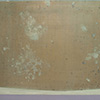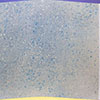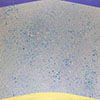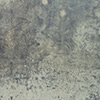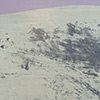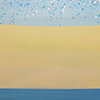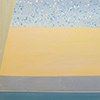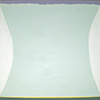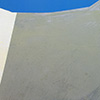
"To all appearances, the artist acts like a mediumistic being who, from the labyrinth beyond time and space, seeks his way out to a clearing. If we give the attributes of a medium to the artist, we must then deny him the state of consciousness on the esthetic plane about what he is doing or why he is doing it. All his decisions in the artistic execution of the work rest with pure intuition and cannot be translated into a self-analysis, spoken or written, or even thought out."
-- Marcel Duchamp "The Creative Act". 1957
"Art is at once surface and symbol."
-- Oscar Wilde
Maybe the most enduring mystery of Champneys Taylor's work has been what his work is "about." And - obliquely - they're about his inner vision, whatever that is, and wherever it goes. Sometimes his paintings have been landscapes with human figures in them (and sometimes, a landscape with a vintage record-player). And sometimes his paintings are apparently abstract, as his newest works seem to be.
But Champ's mysteries are real ones; to a serious extent, they follow the logic of synthetic cubism: That an artist may use visual reality as a springboard to re-visualize its secret timelessness. And this recent work maintains the radical ambiguities pulled out by such timelessness. In "For A.D (Sail)," a possible landscape of gray "sky" mottled by random green droplets is dominated by a massive turquoise geometric shape, not at all a representation of nature, but - possibly - a symbol, possibly a ship's sail; and what may it mean?
It's the artist's intent that you, the viewer, should engage, endure, or enjoy this very quality of open meaningfulness, and all the questions that may continue to arise. "Day for Night," another potential landscape, shows a gray "mountain" below a thin purple sky, affected by a swarm of dark gray forms that seem as likely to be sub-atomic as to be geological features. And the title refers to a cinematic technique for rendering daylight scenes as night scenes. So? Keep wondering....
In a corner of Champ Taylor's studio, he's placed a laminated sheet of paper with two photographs of the early American abstractionist, Arthur Dove, in the sailboat where he and his artist-wife, Reds Torr, lived: A portrait of Dove in the boat, then the boat. Champ, at his job at the Phillips Collection, came to know Dove's work very closely, and is as firmly independent in his visions as Dove was in his.
"What is most primally "independent" in Champneys Taylor's art is his opened imagination, a concept welcome in DC and maybe too few points beyond - that his imagination looks into Something, not anything culturally obvious. Nothing in Champ's work is obvious, but it's steadily, undeniably present."
-- J.W. Mahoney
